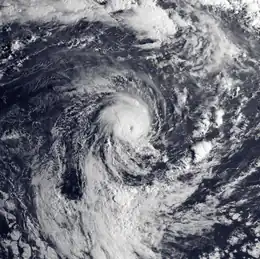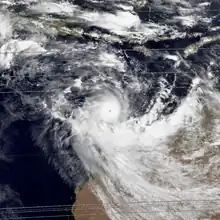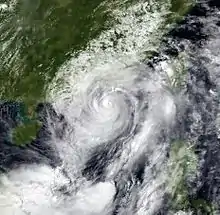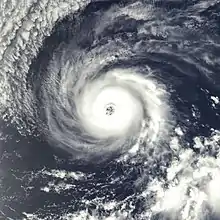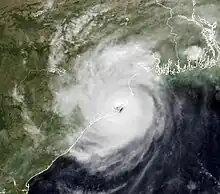| Tropical cyclones in 1999 | |
|---|---|
| Year boundaries | |
| First system | 05F |
| Formed | January 1, 1999 |
| Last system | Astride |
| Dissipated | January 3, 2000 |
| Strongest system | |
| Name | Gwenda |
| Lowest pressure | 900 mbar (hPa); 26.58 inHg |
| Longest lasting system | |
| Name | Dora |
| Duration | 17 days |
| Year statistics | |
| Total systems | 142 |
| Named systems | 72 |
| Total fatalities | ≥ 17,491 |
| Total damage | $5.334 billion (1999 USD) |
During 1999, tropical cyclones formed within seven different bodies of water called basins. To date, 142 tropical cyclones formed in bodies of water known as tropical cyclone basins, of which 72 were given names by various weather agencies. The strongest tropical cyclone of the year was Gwenda, attaining maximum sustained winds of 120 knots (220 km/h; 140 mph) and a pressure of 900 hPa (26.58 inHg), later tied with Inigo in 2003. Floyd was the costliest tropical cyclone of the year, with around $6.5 billion worth of damages as it affected the Bahamas, the East Coast of the United States, and the Atlantic Canada. The deadliest cyclone of this year was the 1999 Odisha cyclone, which was blamed for over 9,667 deaths as it devastated India. It was also the strongest Northern Hemisphere cyclone of the year with the pressure of 912 hPa (26.93 inHg) and third most intense tropical cyclone worldwide next to Cyclone Gwenda and Cyclone Vance. Three Category 5 tropical cyclones were formed in 1999. The accumulated cyclone energy (ACE) index for the 1999 (seven basins combined), as calculated by Colorado State University was 606.4 units.
Global atmospheric and hydrological conditions
A strong La Niña was present for the whole year, which made the Atlantic and North Pacific waters warmer than usual.
Summary

North Atlantic Ocean
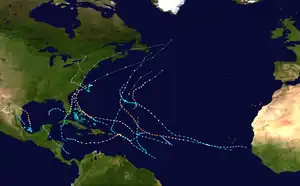
An average Atlantic hurricane season features 12 tropical storms, 6 hurricanes, and 3 major hurricanes, and features an Accumulated Cyclone Energy (ACE) count of 106. The 1999 Atlantic hurricane season had five Category 4 hurricanes – the highest number recorded in a single season in the Atlantic basin, previously tied in 1961, and later tied in 2005 and 2020.
It was a fairly active season, mostly due to a persistent La Niña that developed in the latter half of 1998. The first storm, Arlene, formed on June 11 to the southeast of Bermuda. It meandered slowly for a week and caused no impact on land. Other tropical cyclones that did not affect land were Hurricane Cindy, Tropical Storm Emily, and Tropical Depression Twelve. Localized or otherwise minor damage occurred from Hurricanes Bret, Gert, and Jose, Tropical Storms Harvey and Katrina. The most significant storm of the season was Hurricane Floyd, a strong Category 4 hurricane that caused devastating flooding along the East Coast of the United States, especially in North Carolina. Damage from the storm totaled approximately $6.5 billion (1999 USD) and there were at least 77 fatalities, making it the deadliest hurricane in the United States since Hurricane Agnes in 1972. Flooding from Floyd in North Carolina followed Hurricane Dennis, a slow and erratic–moving storm that dropped heavy rainfall in the eastern portion of the state. Tropical Depression Eleven in October contributed to extreme flooding in Mexico, which left 636 people dead and caused $491.3 million in damage, though impact could not be distinguished from the storm itself. Hurricane Irene caused extensive flooding in Cuba and Florida, with lesser effects in the Bahamas and North Carolina. Irene was the second–costliest storm of the season, with about $800 million in damage. Hurricane Lenny was an unusual eastward–moving storm in the Caribbean Sea and a strong late–season storm. It caused extensive damage in the Lesser Antilles in the month of November.
Eastern and Central Pacific Ocean

An average Pacific hurricane season features 15 tropical storms, 9 hurricanes, and 4 major hurricanes, and features an Accumulated Cyclone Energy (ACE) count of 132. The season produced fourteen tropical cyclones and nine named storms, which was well below the average of sixteen named storms per season; this was largely due to a strong La Niña taking over much of the Pacific.
However, the total of six hurricanes and two major hurricanes during the season was near the averages of eight and three, respectively. Although it remained offshore, Hurricane Adrian caused 6 deaths from flooding and rough surf in Mexico. Hurricane Dora was a long-lived and intense cyclone, which had the second-longest track of a Pacific hurricane on record. The storm brought minor impacts to the island of Hawaii; however, no deaths or damage was reported. The deadliest tropical cyclone, Hurricane Greg, killed 10 people from flooding in Mexico.
Western Pacific Ocean
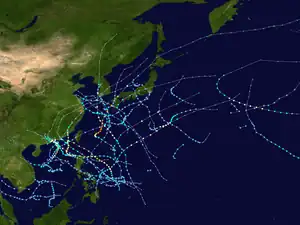
The average typhoon season lasts year-round, with the majority of the storms forming between May and October. An average Pacific typhoon season features 26 tropical storms, 16 typhoons, and 9 super typhoons (unofficial category). It also features an average Accumulated Cyclone Energy (ACE) count of approximately 294; the basin is typically the most active basin for tropical cyclone formation. However, it was a very inactive season, featuring the lowest number of typhoons on record, five.
The 1999 Pacific typhoon season was the last Pacific typhoon season to use English names as storm names. In the season, there were 45 tropical depressions, in which 20 strengthened to tropical storms, of 5 further strengthening into a typhoon. Typhoon Bart was the only super typhoon of that year. Bart reached "super typhoon" status on September 22, when it grew to comprise winds containing a force of 260 km/h (160 mph).
North Indian Ocean

The season produced an average number of storms but there was an above average number of intense cyclones. In May, a Category 3 cyclone struck Pakistan, leaving at 700 people dead or missing. In October, two very intense cyclones struck eastern India within two weeks of each other, leaving over 10,000 people dead and causing more than $4.5 billion (1999 USD) in damages.
A total of ten tropical cyclones were observed. The India Meteorological Department, the official Regional Specialized Meteorological Center of the North Indian Ocean basin, identified eight of them. The Joint Typhoon Warning Center unofficially tracked two additional cyclones, 03B and 31W, during the course of the season.
South-West Indian Ocean
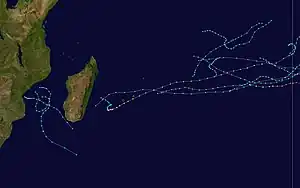

January–June
Activity began late, with the first tropical storm – Alda – forming on January 16, the third latest ever recorded at the time. Alda formed in the Mozambique Channel, which was one of few favorable areas for tropical cyclogenesis in the season. It brought rainfall to southwestern Madagascar that alleviated previously dry conditions. The next five tropical storms either originated or crossed into the adjacent Australian basin, where storms were monitored by the Bureau of Meteorology (BoM). Both Tropical Storm Chikita and Tropical Cyclone Davina brought beneficial rainfall to the Mascarene Islands. The latter storm caused two drowning deaths on Réunion and caused some crop damage. The strongest storm – Evrina – peaked as a strong cyclone in the Australian but weakened upon crossing 90°E, with 10-minute maximum sustained winds of 175 km/h (110 mph) in the basin. The final storm was unnamed, crossing from the Australian basin on April 21 as a minimal tropical storm before quickly dissipating. There were also several tropical disturbances or depressions, many short-lived. The first of these formed on September 3 in the northeastern portion of the basin, and there was a tropical depression in February in the Mozambique Channel that approached tropical storm status.
July–December
Despite the destructive nature of the season, it began later than usual. Cyclone Astride originated toward the end of December, bringing rainfall and gusty winds to northern Madagascar while in the region.
Australian Region
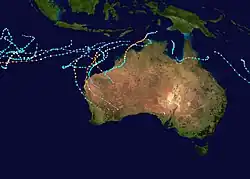

January–June
The season featured Cyclone Gwenda, the most intense tropical cyclone in the Australian Region (later tied with Inigo in 2003) . It was above average, with 14 tropical lows, with 9 further strengthening to a tropical cyclone, with 6 of those further becoming a severe tropical cyclone. The 1999 season started with Olinda forming on late January, exiting toward the South Pacific basin the next day. Damien, Rona, Elaine, Vance, Frederick, and Gwenda further strengthened to severe tropical cyclones. Hamish ended the season, exiting the basin to the South-West Indian Ocean on 21 April.
July–December
3 tropical cyclones formed on late 1999, with 2 of them further becoming tropical cyclones: A tropical low, Ilsa, and John. Ilsa and John briefly affected Western Australia. A tropical low near Brisbane existed from 2 – 3 December.
South Pacific Ocean
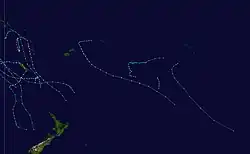

January–June
The 1998–99 South Pacific cyclone season was a near average South Pacific tropical cyclone season, with 8 tropical cyclones occurring within the South Pacific Ocean basin between 160°E and 120°W. Despite the season starting on November 1, the first tropical system of the season did not form until December 1, while the final disturbance of the season dissipated on May 27, 1999. During the season the most intense tropical cyclone was Severe Tropical Cyclone Cora, which had a minimum pressure of 930 hPa (27.46 inHg). After the season had ended the names Cora and Dani were retired from the naming lists, after they had caused significant impacts to South Pacific islands.
July–December
5 tropical depressions formed throughout the year; however, they were all weak. A tropical depression existed from September and 4 more tropical depressions monitored by the FMS existed from November to early December.
Mediterranean Sea
2 medicanes were observed in March 19–21, 1999 and September 13, 1999.
Systems
January
| Storm name | Dates active | Max wind km/h (mph) |
Pressure (hPa) |
Areas affected | Damage (USD) |
Deaths | Refs |
|---|---|---|---|---|---|---|---|
| 05F | January 1–5 | Not specified | Not specified | Cook Islands | None | None | |
| 06F | January 3 | Not specified | Not specified | French Polynesia | None | None | |
| A4 | January 3–5 | 55 (35) | 996 | Madagascar | None | None | |
| Hilda (Auring) | January 3–8 | 55 (35) | 1000 | Malaysia | $1.3 million | 5 | [1][2] |
| Alda | January 14–19 | 105 (65) | 975 | Mozambique, Madagascar | Unknown | None | [3] |
| Dani | January 15–22 | 175 (110) | 930 | Vanuatu, New Caledonia, Fiji | $8.5 million | 12 | [4][5] |
| 08F | January 16–20 | Unknown | Unknown | Fiji | $1.8 million | 6 | |
| Olinda | January 20–23 | 100 (65) | 985 | New Caledonia | Unknown | None | |
| Damien–Birenda | January 21–February 2 | 155 (100) | 950 | Cocos Islands | None | None | |
| Pete | January 21–26 | 100 (65) | 985 | New Caledonia | Unknown | None | [6] |
| 16P | January 24–27 | 55 (35) | 993 | Northern Territory | Unknown | None | |
| Chikita | January 29–February 4 | 65 (40) | 990 | Réunion, Mauritius, Rodrigues | Unknown | None | |
| 18S | January 31–February 14 | 75 (45) | 995 | Western Australia | Unknown | None | [7] |
February
| Storm name | Dates active | Max wind km/h (mph) |
Pressure (hPa) |
Areas affected | Damage (USD) |
Deaths | Refs |
|---|---|---|---|---|---|---|---|
| BOB 01 | February 2–5 | 95 (60) | 998 | Sri Lanka | None | None | |
| 11F | February | Unknown | Unknown | None | None | None | |
| 12F | February | Unknown | Unknown | None | None | None | |
| 13F | February | Unknown | Unknown | None | None | None | |
| Rona | February 9–12 | 140 (85) | 970 | Queensland | None | None | |
| TD | February 9–10 | Not specified | 1004 | None | None | None | |
| Ella | February 9–13 | 85 (50) | 985 | Solomon Islands, Vanuatu, New Caledonia | None | None | |
| 15F | February | Unknown | Unknown | None | None | None | |
| D1 | February 11–17 | 55 (35) | 994 | Mozambique, Madagascar | None | None | |
| Iris (Bebeng) | February 14–19 | 55 (35) | 1000 | Chuuk, Palau | None | None | |
| Frank | February 16–21 | 150 (90) | 955 | Eastern Australia, New Caledonia | $150 million | 7 | |
| 17F | February 17–19 | 75 (45) | 995 | Fiji | None | None | |
| D2-E1 | February 23–March 6 | 45 (30) | 1000 | Mozambique, Madagascar | None | None | |
| Gita | February 27–March 2 | 85 (50) | 990 | Cook Islands | None | None | |
March
| Storm name | Dates active | Max wind km/h (mph) |
Pressure (hPa) |
Areas affected | Damage (USD) |
Deaths | Refs |
|---|---|---|---|---|---|---|---|
| Davina | March 2–19 | 165 (105) | 930 | Rodrigues | Minor | 2 | |
| TL | March 7–14 | 65 (40) | 1000 | Unknown | None | None | |
| E2 | March 8–20 | Unknown | Unknown | Mauritius | None | None | |
| E3 | March 11–21 | Unknown | Unknown | None | None | None | |
| Hali | March 11–18 | 120 (75) | 970 | Cook Islands | None | None | |
| 20F | March 13–18 | 65 (40) | 998 | None | None | None | |
| Elaine | March 15–20 | 165 (105) | 945 | Western Australia | Unknown | Unknown | |
| Vance | March 15–24 | 215 (130) | 910 | Northern Territory, Western Australia, South Australia, Victoria, Tasmania | $100 million | None | |
| TL | March 20–21 | ≤ 65 (40) | 996 | Unknown | None | None | |
| Frederick-Evrina | March 25 – April 10 | 205 (125) | 920 | None | None | None | |
| 21F | March 28 | Unknown | Unknown | None | None | None | |
April
| Storm name | Dates active | Max wind km/h (mph) |
Pressure (hPa) |
Areas affected | Damage (USD) |
Deaths | Refs |
|---|---|---|---|---|---|---|---|
| Gwenda | April 2–8 | 220 (140) | 900 | Western Australia | Minimal | None | |
| Jacob (Katring) | April 6–9 | 55 (35) | 1006 | Philippines | None | None | |
| 22F | April 9 | Unknown | Unknown | None | None | None | |
| TL | April 16 – 19 | 80 (50) | 999 | Unknown | None | None | [nb 1] |
| Hamish | April 19–21 | 100 (65) | 980 | None | None | None | [nb 2] |
| F1 | April 21–24 | 65 (40) | 992 | None | None | None | [nb 3] |
| 23F | April 21 | Unknown | Unknown | None | None | None | |
| Kate (Diding) | April 21–28 | 100 (65) | 980 | Philippines | None | None | |
| Leo | April 27 – May 2 | 120 (75) | 970 | China | Unknown | Unknown | |
May
| Storm name | Dates active | Max wind km/h (mph) |
Pressure (hPa) |
Areas affected | Damage (USD) |
Deaths | Refs |
|---|---|---|---|---|---|---|---|
| ARB 01 | May 16–22 | 195 (120) | 946 | India, Pakistan | $6 million | 6,400 | |
| 26F | May 20–26 | 75 (45) | 995 | Queensland, New Zealand | None | None | |
June
| Storm name | Dates active | Max wind km/h (mph) |
Pressure (hPa) |
Areas affected | Damage (USD) |
Deaths | Refs |
|---|---|---|---|---|---|---|---|
| Maggie (Etang) | June 1–9 | 140 (85) | 955 | Philippines, Taiwan, Japan, Vietnam, China | $168 million | 9 | [8][9] |
| TD | June 1–2 | Not specified | 1004 | None | None | None | [10] |
| Gening | June 3–6 | 55 (35) | 996 | None | None | None | |
| 03B | June 8–11 | 65 (40) | 997 | India | None | None | |
| TD | June 9–15 | 55 (35) | 996 | Japan | None | None | |
| Arlene | June 11–18 | 95 (60) | 1006 | Bermuda | None | None | |
| BOB 02 | June 17 | 55 (35) | 986 | India | None | None | |
| Adrian | June 18–22 | 155 (100) | 973 | Mexico | None | 6 | |
July
| Storm name | Dates active | Max wind km/h (mph) |
Pressure (hPa) |
Areas affected | Damage (USD) |
Deaths | Refs |
|---|---|---|---|---|---|---|---|
| Two | July 2–3 | 55 (35) | 1003 | Mexico | None | None | |
| Beatriz | July 9–17 | 195 (120) | 955 | None | None | None | |
| TD | July 9–15 | 55 (35) | 996 | Japan | None | None | |
| Three-E | July 14–15 | 55 (35) | 1007 | Mexico, Honduras, Nicaragua | None | None | |
| 07W | July 14–18 | 65 (40) | 996 | None | None | None | |
| 08W | July 19–23 | 55 (35) | 1004 | Japan, South Korea | None | None | |
| Neil (Helming) | July 22–28 | 95 (60) | 980 | Japan, Korea, Ryukyu Islands | Unknown | ≥ 8 | [11][12] |
| Four-E | July 23–25 | 55 (35) | 1007 | None | None | None | |
| 10W | July 23–28 | 75 (45) | 985 | China | None | None | |
| Calvin | July 25–27 | 65 (40) | 1005 | None | None | None | |
| Six-E | July 26–28 | 55 (35) | 1005 | None | None | None | |
| BOB 03 | July 27–28 | 55 (35) | 990 | India | Unknown | Unknown | |
| Olga | July 29 – August 3 | 120 (75) | 970 | Caroline Islands, Ryukyu Islands, Korea | $657 million | 106 | [13][14][15] |
August
| Storm name | Dates active | Max wind km/h (mph) |
Pressure (hPa) |
Areas affected | Damage (USD) |
Deaths | Refs |
|---|---|---|---|---|---|---|---|
| Paul | August 3–9 | 85 (50) | 980 | Japan, China, Mariana Islands, Korea | Unknown | None | [16] |
| Rachel | August 5–11 | 65 (40) | 992 | Taiwan, Ryukyu Islands, China | None | None | |
| BOB 04 | August 6–9 | 45 (30) | 992 | India | None | None | [17] |
| Dora | August 6–23 | 220 (140) | 943 | Hawaii, Johnston Atoll | Minimal | None | [18] |
| Eugene | August 6–15 | 175 (110) | 964 | Hawaii | None | None | |
| 14W | August 8–10 | 45 (30) | 1000 | Japan | None | None | |
| TD | August 9–11 | Not specified | 1000 | None | None | None | |
| TD | August 11 | Not specified | 1000 | None | None | None | |
| TD | August 11–16 | Not specified | 1000 | Japan | None | None | |
| Nine-E | August 13–15 | 55 (35) | 1005 | None | None | None | |
| 15W | August 16–18 | 45 (30) | 1002 | Korea, Japan | None | None | |
| TD | August 16–17 | Not specified | 1010 | None | None | None | |
| Fernanda | August 17–22 | 100 (65) | 994 | None | None | None | |
| Sam | August 17–24 | 100 (65) | 980 | Philippines, China | $35 million | 20 | [19][20] |
| Bret | August 18–25 | 230 (145) | 944 | Texas, Mexico | $15 million | 7 | [21][22] |
| Cindy | August 19–31 | 220 (140) | 942 | Cape Verde, Bermuda | None | 1 | [23][24] |
| Tanya | August 19–24 | 95 (60) | 1000 | None | None | None | |
| 18W | August 21–24 | 55 (35) | 1000 | None | None | None | |
| Eleven-E | August 23–24 | 55 (35) | 1000 | Baja California Peninsula | None | None | |
| Virgil | August 23–29 | 95 (60) | 994 | None | None | None | |
| Dennis | August 24 – September 9 | 165 (105) | 962 | The Bahamas, Florida, Georgia, North Carolina, Virginia, Mid-Atlantic, New England, Ontario, Quebec | $157 million | 6 | [25][26] |
| Emily | August 24–28 | 85 (50) | 1004 | None | None | None | |
| Wendy (Mameng) | August 29 – September 4 | 65 (40) | 995 | Philippines, China | $309.4 million | 133 | [27] |
| TD | August 30 | Not specified | 1008 | None | None | None | |
September
| Storm name | Dates active | Max wind km/h (mph) |
Pressure (hPa) |
Areas affected | Damage (USD) |
Deaths | Refs |
|---|---|---|---|---|---|---|---|
| Greg | September 5–9 | 120 (75) | 986 | Mexico, Baja California Peninsula | Moderate | 10 | [28] |
| Seven-E | September 5–7 | 55 (35) | 1006 | Mexico, Texas | Unknown | None | [29] |
| TD | September 5–6 | 65 (40) | 1000 | None | None | None | [30] |
| Floyd | September 7–19 | 250 (155) | 921 | The Bahamas, East Coast of the United States, Atlantic Canada | $6.5 billion | 85 | [31][32][33] |
| York (Neneng) | September 10–17 | 100 (65) | 980 | Philippines, China | $34 million | 35 | [34][35][36] |
| Gert | September 11–23 | 240 (150) | 930 | Bermuda, Maine, Atlantic Canada | $1.9 million | 2 | [37] |
| Zia | September 11–15 | 85 (50) | 985 | Japan | Unknown | 9 | [38] |
| Ann | September 14–19 | 95 (60) | 985 | Taiwan, China, Korea, Ryukyu Islands | Unknown | None | [39][40] |
| Hillary | September 17–21 | 120 (75) | 987 | Baja California Peninsula | None | None | [41] |
| Bart (Oniang) | September 17–30 | 165 (105) | 930 | Taiwan, Ryukyu Islands, Japan, South Korea, North Korea, Russia | $5.75 billion | 36 | [42][43] |
| Harvey | September 19–22 | 95 (60) | 994 | Florida, Georgia, North Carolina, South Carolina, Atlantic Canada | ≥ $22.6 million | None | [44] |
| TD | September 21 | Not specified | 1008 | None | None | None | |
| Cam | September 22–26 | 85 (50) | 992 | China | Unknown | 1 | [45] |
October
| Storm name | Dates active | Max wind km/h (mph) |
Pressure (hPa) |
Areas affected | Damage (USD) |
Deaths | Refs |
|---|---|---|---|---|---|---|---|
| Dan (Pepang) | October 2–10 | 150 (90) | 955 | South Korea, Philippines, Taiwan, China | $242 million | 44 | |
| Eleven | October 4–6 | 55 (35) | 1002 | Mexico | Unknown | Unknown | |
| Twelve | October 6–8 | 55 (35) | 1007 | None | None | None | |
| Irwin | October 8–11 | 95 (60) | 996 | Southwestern Mexico, Guerrero | Minimal | None | |
| Irene | October 12–19 | 175 (110) | 958 | Cuba, Bahamas, Southeastern United States | $800 million | 18 | |
| Eve (Rening) | October 15–20 | 85 (50) | 990 | Philippines, Vietnam | $235 million | 590 | |
| BOB 05 | October 15–19 | 165 (105) | 968 | India, Myanmar | Unknown | 80 | |
| Jose | October 17–25 | 155 (100) | 979 | Lesser Antilles, Puerto Rico | $5 million | 3 | |
| TD | October 23–24 | Not specified | 1004 | Vietnam, Thailand | None | None | |
| BOB 06 | October 25–31 | 260 (160) | 912 | India, Thailand, Myanmar, Bangladesh | $4.44 billion | 9,887 | |
| Katrina | October 28–November 1 | 65 (40) | 999 | Central America, Mexico | $9,000 | None |
November
| Storm name | Dates active | Max wind km/h (mph) |
Pressure (hPa) |
Areas affected | Damage (USD) |
Deaths | Refs |
|---|---|---|---|---|---|---|---|
| TD | November 5 | Not specified | 1002 | Vietnam | None | None | |
| 28W | November 5–6 | 55 (35) | 1000 | None | None | None | |
| Frankie (Sendang) | November 6–10 | 55 (35) | 996 | Philippines | None | None | |
| Lenny | November 13–23 | 250 (155) | 933 | Colombia, Puerto Rico, Leeward Islands | $785.8 million | 17 | |
| Gloria (Trining) | November 13–16 | 95 (60) | 980 | None | None | None | |
December
| Storm name | Dates active | Max wind km/h (mph) |
Pressure (hPa) |
Areas affected | Damage (USD) |
Deaths | Refs |
|---|---|---|---|---|---|---|---|
| 31W | December 1–5 | 55 (35) | 1000 | Thailand, Vietnam | None | None | |
| 03F | December 1–3 | 55 (35) | 1006 | None | None | None | |
| TL | December 2–3 | 55 (35) | 1002 | Queensland | None | None | |
| 04F | December 5–7 | 65 (40) | 1003 | None | None | None | |
| BOB 07 | December 8–10 | 45 (30) | 998 | India, Sri Lanka | None | None | |
| Ilsa | December 9–17 | 100 (65) | 980 | Christmas Island, Western Australia | Unknown | None | |
| 32W | December 9–11 | 55 (35) | 1000 | Vietnam, Cambodia | None | None | |
| John | December 9–16 | 205 (125) | 915 | Western Australia | Unknown | None | |
| 33W | December 14–16 | 55 (35) | 1000 | Vietnam | Unknown | None | |
| Astride | December 23 – January 3 | 95 (60) | 985 | Réunion, Mozambique, Madagascar, Mauritius, Rodrigues | Minor | None | |
Global effects
See also
Notes
2 Only systems that formed either on or after January 1, 1999 are counted in the seasonal totals.
3 Only systems that formed either before or on December 31, 1999 are counted in the seasonal totals.
4 The wind speeds for this tropical cyclone/basin are based on the IMD Scale which uses 3-minute sustained winds.
5 The wind speeds for this tropical cyclone/basin are based on the Saffir Simpson Scale which uses 1-minute sustained winds.
6The wind speeds for this tropical cyclone are based on Météo-France which uses wind gusts.
References
- ↑ Joint Typhoon Warning Center. "Bwp011999.txt". 1999 Joint Typhoon Warning Center Best Track. Retrieved 2013-08-19.
- ↑ Padgett, Gary. "Monthly Global Tropical Cyclone Summary: January 1999". Archived from the original on 2007-02-09. Retrieved 2007-02-17.
- ↑ Kenneth R. Knapp; Michael C. Kruk; David H. Levinson; Howard J. Diamond; Charles J. Neumann (2010). 1999 Alda (1999015S20036). The International Best Track Archive for Climate Stewardship (IBTrACS): Unifying tropical cyclone best track data (Report). Bulletin of the American Meteorological Society. Archived from the original on 2016-03-05. Retrieved 2014-01-23.
- ↑ Republic of Vanuatu's National Advisory Committee on Climate Change (September 27, 2007). "National adaptation programme for action" (PDF). United Nations Framework Convention on Climate Change. p. 16. Retrieved January 14, 2012.
- ↑ Phillips, Brian (July 20, 2009). "Environmental Degradation and migration – the experiences of Vanuatu" (PDF). Vanuatu Meteorological Service. Institute of Policy Studies. Retrieved January 14, 2012.
- ↑ Joint Typhoon Warning Center (2000). "Tropical Cyclone 14P (Pete) Best Track Analysis". United States Navy, United States Air Force. Retrieved February 20, 2012.
- ↑ Gary Padgett (1999). "Monthly Global Tropical Cyclone Summary, January 1999". Retrieved 18 July 2008.
- ↑ Hong Kong Observatory. "Typhoon Maggie (9903): 2-8 June 1999" (PDF). 1999 Hong Kong Observatory Report. Archived from the original (PDF) on 26 September 2013. Retrieved 2013-08-19.
- ↑ Kenji Yoshida; Hisanori Itoh (February 22, 2012). Indirect Effects of Tropical Cyclones on Heavy Rainfall Events in Kyushu, Japan, During the Baiu Season (Report). Retrieved August 19, 2018.
- ↑ Padgett, Gary. "Monthly Global Tropical Cyclone Summary: June 1999". Archived from the original on 2007-02-09. Retrieved 2007-02-17.
- ↑ Newman, Steve (1999-08-06). "Earthweek – A Diary of the Planet". CNN. Retrieved 2007-02-18.
- ↑ Joint Typhoon Warning Center. "Tropical Storm Neil (09W)" (PDF). 1999 Annual Tropical Cyclone Report. p. 48. Archived from the original (PDF) on 2016-12-24. Retrieved 2013-08-19.
- ↑ Dartmouth Flood Observatory. "1999 Flood Archive". Archived from the original on February 26, 2008. Retrieved February 18, 2007.
- ↑ Joint Typhoon Warning Center. "Typhoon Olga (11W)" (PDF). 1999 Annual Tropical Cyclone Report. p. 56. Archived from the original (PDF) on December 24, 2016. Retrieved August 19, 2013.
- ↑ Padgett, Gary. "Monthly Global Tropical Cyclone Summary: July 1999". Archived from the original on March 23, 2007. Retrieved February 17, 2007.
- ↑ Joint Typhoon Warning Center. "Tropical Storm Paul (12W)" (PDF). 1999 Annual Tropical Cyclone Report. p. 63. Archived from the original (PDF) on 2016-12-24. Retrieved 2013-08-19.
- ↑ Northern Hemisphere 1999 Tropical Cyclone Season Review
- ↑ Miles B. Lawrence; Todd B. Kimberlain (November 23, 1999). Hurricane Dora Preliminary Report (PDF). National Hurricane Center (Report). National Oceanic and Atmospheric Administration. Retrieved January 4, 2017.
- ↑ Padgett, Gary. "Monthly Global Tropical Cyclone Summary: August 1999". Archived from the original on March 23, 2007. Retrieved February 17, 2007.
- ↑ Joint Typhoon Warning Center. "Typhoon Sam (16W)" (PDF). 1999 Annual Tropical Cyclone Report. p. 76. Archived from the original (PDF) on December 24, 2016. Retrieved August 19, 2013.
- ↑ "Mata a 3 coletazo de ' Bret '". El Norte (in Spanish). August 25, 1999. p. 1.
- ↑ "Evacuan a 7 familias en Apodaca". El Norte (in Spanish). August 26, 1999. p. 16.
- ↑ John L. Guiney (December 9, 1999). Preliminary Report: Hurricane Cindy (PDF). National Hurricane Center (Report). Miami, Florida: National Oceanic and Atmospheric Administration. Retrieved March 13, 2015.
- ↑ Jack L. Beven (August 20, 1999). Tropical Storm Cindy Discussion Number 8 (TXT). National Hurricane Center (Report). Miami, Florida: National Oceanic and Atmospheric Administration. Retrieved July 14, 2011.
- ↑ Jack L. Beven (January 11, 2000). Preliminary Report: Hurricane Dennis (PDF). National Hurricane Center (Report). Miami, Florida: National Oceanic and Atmospheric Administration. Retrieved April 28, 2019.
- ↑ Estes Thompson (August 31, 1999). "Dennis pummels N.C. coast; turns seaward". The Daily Spectrum. Associated Press. p. A8. Retrieved June 28, 2019 – via Newspapers.com.

- ↑ "Wendy Death Toll hits 133". China Daily. September 7, 1999. Retrieved 2009-08-31.
- ↑ "10 dead as Hurricane Greg lashes Mexico". The Associated Press. September 7, 1999. – via Lexis Nexis (subscription required)
- ↑ David M. Roth (May 1, 2009). Tropical Depression #7 - September 3-10, 1999. Weather Prediction Center (Report). College Park, Maryland: National Oceanic and Atmospheric Administration. Archived from the original on 25 July 2011. Retrieved March 13, 2015.
- ↑ Padgett, Gary. "Monthly Global Tropical Cyclone Tracks September 1999". Archived from the original on 2019-07-09. Retrieved 2012-04-01.
- ↑ Costliest U.S. tropical cyclones tables updated (PDF) (Report). Miami, Florida: National Hurricane Center. January 26, 2018. Retrieved January 29, 2018.
- ↑ Graef, Rick. "The Abacos' Hurricane Floyd Information Pages Relief and Rebuilding Reports and Updates". Go-Abacos.Com. Retrieved October 4, 2008.
- ↑ Herring, David (2000). "Hurricane Floyd's Lasting Legacy". NASA. Retrieved October 4, 2008.
- ↑ Staff Writer (1999-09-17). "China typhoon strands thousands". BBC. Retrieved 2007-02-17.
- ↑ Hong Kong Observatory (April 2000). "Typhoon York (9915)" (PDF). Tropical cyclones in 1999. pp. 73–83. Archived from the original (PDF) on 2011-05-24. Retrieved 2007-02-18.
- ↑ Padgett, Gary. "Monthly Global Tropical Cyclone Summary: September 1999". Archived from the original on 23 March 2007. Retrieved 2007-02-17.
- ↑ Miles B. Lawrence (2000-07-22). "Hurricane Gert Preliminary Report". National Hurricane Center. Retrieved 2011-05-25.
- ↑ Joint Typhoon Warning Center. "Tropical Storm Zia (22W)" (PDF). 1999 Annual Tropical Cyclone Report. p. 95. Archived from the original (PDF) on 2016-12-24. Retrieved 2013-08-19.
- ↑ USDA; NOAA (1999-09-28). "Weekly Weather and Crop Bulletin" (PDF). p. 21. Archived from the original (pdf) on 2006-09-21. Retrieved 2007-02-17.
- ↑ Joint Typhoon Warning Center. "Tropical Storm Ann (23W)" (PDF). 1999 Annual Tropical Cyclone Report. p. 98. Archived from the original (PDF) on 2016-12-24. Retrieved 2013-08-19.
- ↑ Miles B. Lawrence (December 1, 1999). Preliminary Report: Hurricane Hilary (Report). National Hurricane Center. Retrieved March 1, 2013.
- ↑ "Modelling Typhoons in Japan" (PDF). Margaret Joseph. September 7, 2016. Retrieved September 8, 2018.
- ↑ "BREAKING NEWS: BART SLAMS INTO JAPAN". CNN. September 22, 1999.
- ↑ John Guiney (December 9, 1999). "Tropical Storm Harvey Tropical Cyclone Report". National Hurricane Center. Retrieved November 28, 2009.
- ↑ Joint Typhoon Warning Center. "Tropical Storm Cam (25W)" (PDF). 1999 Annual Tropical Cyclone Report. p. 108. Archived from the original (PDF) on 2016-12-24. Retrieved 2013-08-19.
External links
| Tropical cyclone year articles (1990–1999) |
|---|
| 1990, 1991, 1992, 1993, 1994, 1995, 1996, 1997, 1998, 1999 |
Regional Specialized Meteorological Centers
- US National Hurricane Center – North Atlantic, Eastern Pacific
- Central Pacific Hurricane Center – Central Pacific
- Japan Meteorological Agency – NW Pacific
- India Meteorological Department – Bay of Bengal and the Arabian Sea
- Météo-France – La Reunion – South Indian Ocean from 30°E to 90°E
- Fiji Meteorological Service – South Pacific west of 160°E, north of 25° S
Tropical Cyclone Warning Centers
- Meteorology, Climatology, and Geophysical Agency of Indonesia – South Indian Ocean from 90°E to 141°E, generally north of 10°S
- Australian Bureau of Meteorology (TCWC's Perth, Darwin & Brisbane) – South Indian Ocean & South Pacific Ocean from 90°E to 160°E, generally south of 10°S
- Papua New Guinea National Weather Service – South Pacific Ocean from 141°E to 160°E, generally north of 10°S
- Meteorological Service of New Zealand Limited – South Pacific west of 160°E, south of 25°S
![]() This article incorporates public domain material from websites or documents of the National Weather Service.
This article incorporates public domain material from websites or documents of the National Weather Service.


